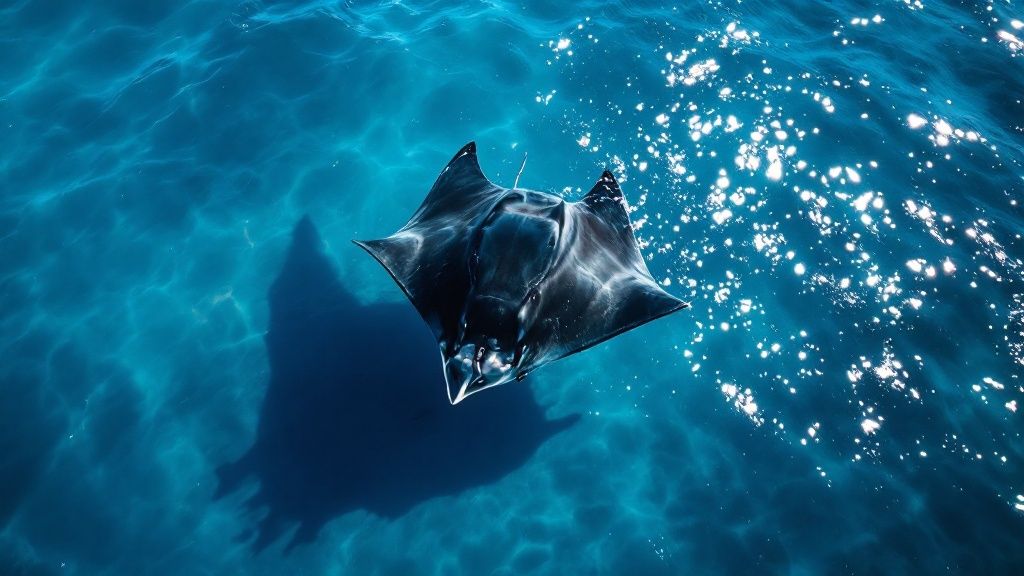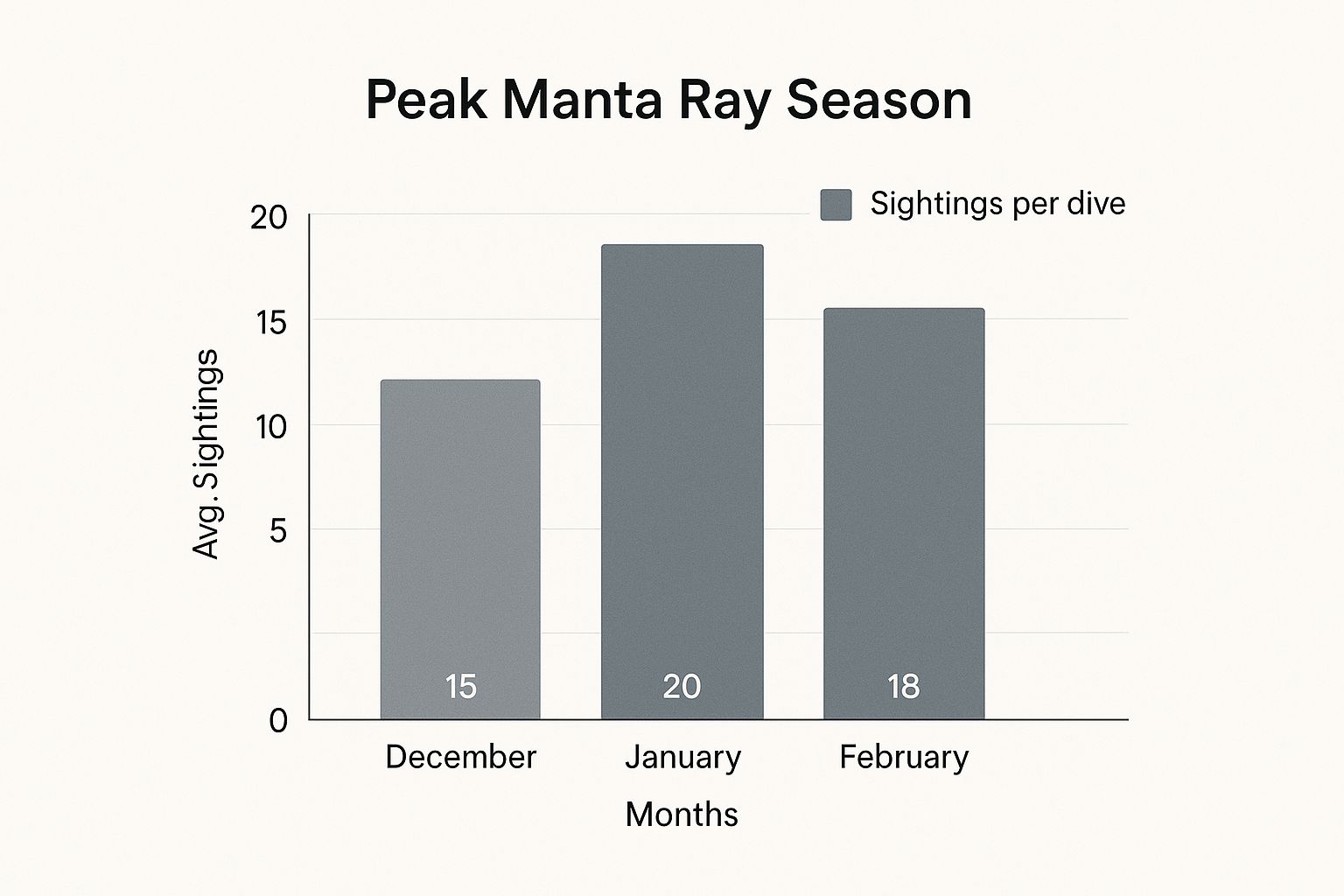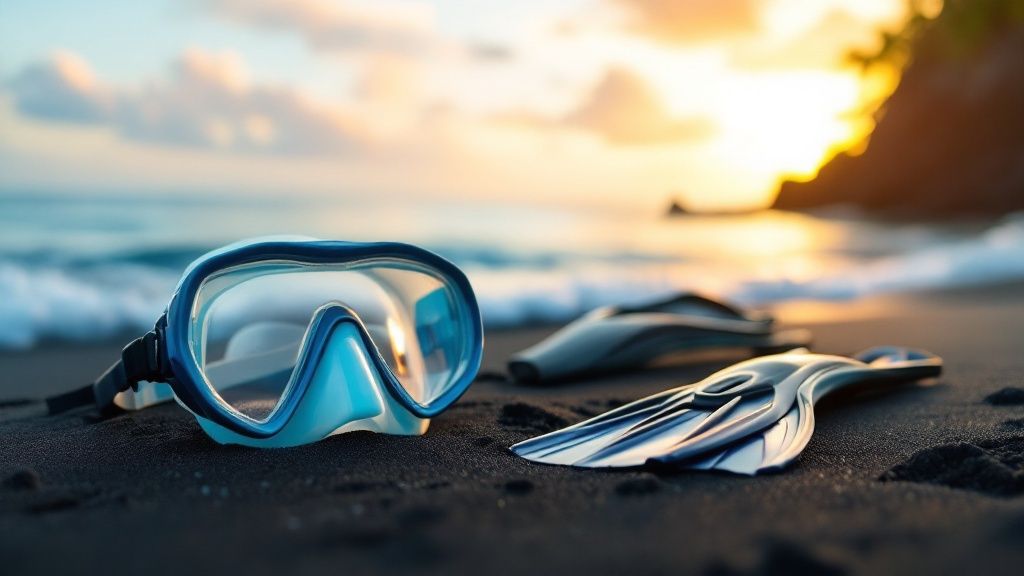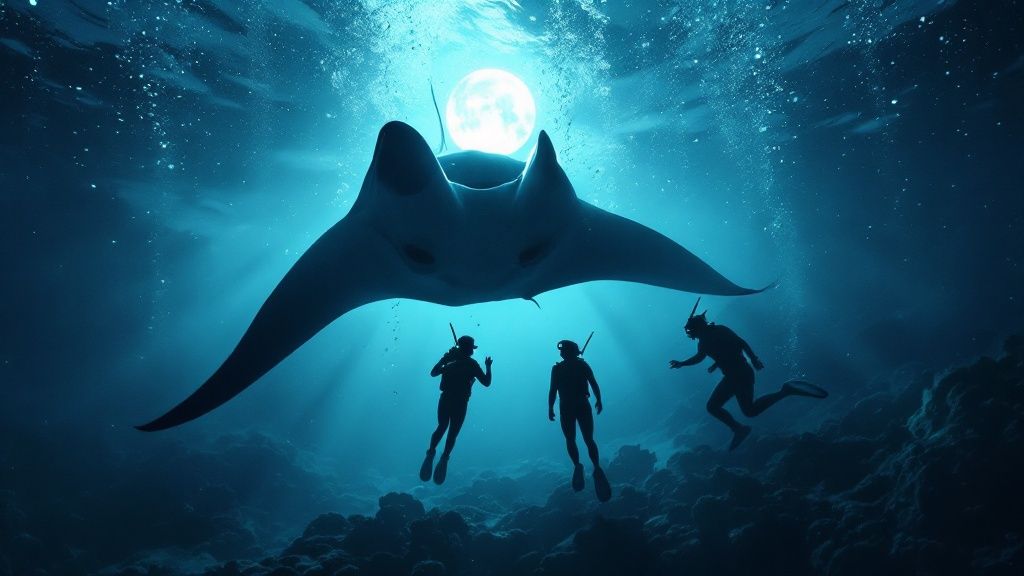Manta Ray Snorkel Kona | Unforgettable Ocean Encounters
- Byron
- May 7
- 11 min read
The Magic Behind Kona's Manta Ray Encounters
The Kona Coast of Hawaii has become a world-renowned destination for manta ray encounters, attracting visitors eager to snorkel alongside these gentle giants. This popularity isn't accidental; a unique combination of environmental factors creates a perfect habitat, making Kona a true manta ray paradise.
The volcanic landscape of the Kona Coast plays a crucial role. The sloping seabed and underwater terrain form channels that concentrate plankton, the manta ray's main food source. This natural funneling effect creates spectacular feeding displays, drawing mantas close to shore. The volcanic rock also provides shelter and cleaning stations.
This abundance of food is amplified by an unexpected source: coastal development. Resort lighting along the shoreline attracts plankton, creating concentrated feeding grounds. This lures manta rays closer to the surface, making them easily accessible to snorkelers. This interplay of natural and human-influenced elements has established Kona as a reliable and unforgettable location for these encounters.
The Kona Coast attracts approximately 80,000 snorkelers annually hoping to see manta rays. This immense popularity is due to the high sighting success rate, which ranges between 80% and 90% year-round. This means snorkelers have a very high chance of an encounter on any given trip. The two primary snorkeling sites are Manta Village (Garden Eel Cove) and Manta Heaven (Keauhou Bay). For further statistics, visit: Manta Ray Snorkel Kona Statistics.
Understanding Kona's Manta Ray Hotspots
When choosing your manta ray tour operator in Kona, consider the types of snorkeling tours offered to match your skill level and comfort. Some operators specialize in longer excursions, even offering marathon snorkeling tours. Both Manta Village and Manta Heaven offer unique experiences.
Manta Village, with shallower depths of 30 to 40 feet, is ideal for beginners. Manta Heaven, averaging 35 feet with depths ranging from 20 to 50 feet, offers calmer waters, better for those susceptible to seasickness.
The Allure of the Manta Ray
These gentle giants, with wingspans reaching up to 16 feet, fascinate travelers worldwide. A manta ray snorkel in Kona isn't just a fun activity; it's often described as a life-changing wildlife encounter, comparable to swimming with whales or diving with sharks. For more trip planning information, you might be interested in: Our Sitemap.

This unique ecosystem and the gentle nature of these magnificent creatures make Kona a premier destination for a truly unforgettable manta ray experience.
Insider's Guide to Kona's Premier Manta Ray Sites
Choosing the right snorkel spot can make or break your manta ray experience in Kona. Understanding the unique characteristics of the two most popular locations, Manta Village (Garden Eel Cove) and Manta Heaven (Keauhou Bay), is key to planning your adventure. While both locations offer amazing manta ray viewing, they cater to different preferences.
Manta Village: Up Close and Personal
Manta Village, nestled in Garden Eel Cove, is known for its shallower depths, typically between 30 to 40 feet. This makes it perfect for beginners and families with children. The shallow water also provides excellent visibility, creating opportunities for incredibly close encounters with these graceful giants. The unique bottom topography of Manta Village concentrates plankton, leading to focused feeding activity and often, more dynamic manta ray behavior, such as impressive barrel rolls.
Manta Heaven: A Calmer, Deeper Experience
Manta Heaven, located in Keauhou Bay, offers a contrasting experience. With depths averaging 35 feet, and ranging from 20 to 50 feet, it boasts calmer waters sheltered from open ocean swells. This is a significant advantage for those susceptible to seasickness. Manta Heaven tends to attract larger groups of manta rays, making for a truly immersive experience. The wider, deeper bay allows the manta rays to glide effortlessly, offering a more serene viewing experience compared to the sometimes energetic atmosphere of Manta Village.
To help you choose the best spot for your snorkeling adventure, we've created a comparison table highlighting the key features of each location:
Comparison of Kona's Top Manta Ray Snorkel Sites
A detailed comparison of the two main manta ray snorkeling locations in Kona, highlighting key differences to help visitors choose the best site for their experience.
Location Feature | Manta Village (Garden Eel Cove) | Manta Heaven (Keauhou Bay) |
|---|---|---|
Average Depth | 30-40 feet | 35 feet (ranging from 20-50 feet) |
Water Conditions | Can be more active | Generally calmer, protected from swells |
Manta Ray Behavior | Often more dynamic feeding, barrel rolls | Graceful gliding, larger congregations |
Suitability | Ideal for beginners and families | Good for those prone to seasickness, those seeking larger groups |
As you can see, each location provides a unique perspective on these magnificent creatures. Consider your experience level and what kind of encounter you’re hoping for when making your choice.
Choosing the Right Site for You
So, which site is the right fit for you? If you're a novice snorkeler, or prefer shallower water and close-up encounters, Manta Village is a fantastic choice. If you're looking for calmer waters and the possibility of seeing larger groups of manta rays, Manta Heaven might be the better option.

This "Peak Manta Ray Season" infographic shows the average manta ray sightings per dive during peak months. January boasts the highest average sightings, with December and February following closely. This highlights that while manta rays are present year-round, certain months statistically offer a higher chance of an encounter. You can explore more on our blog categories. Both sites offer incredible opportunities to witness the magic of manta rays, and understanding their subtle differences can truly enhance your Kona manta ray snorkeling adventure.
Timing Your Encounter: When Mantas Show Up Most

While the magic of manta rays graces Kona's waters year-round, understanding seasonal nuances can greatly enhance your snorkeling adventure. Choosing the right time can dramatically increase your chances of a truly memorable encounter.
Decoding Seasonal Patterns
Manta rays are attracted to Kona by the abundance of plankton, their primary food source. Plankton blooms, influenced by water temperature and nutrient levels, fluctuate throughout the year. This means certain times offer more concentrated feeding activity, potentially leading to more dynamic manta ray behavior. Water clarity and surface conditions also vary seasonally, impacting visibility and overall snorkeling comfort.
Peak Season Perks and Considerations
April to October is generally considered peak season for manta ray snorkeling in Kona. During these months, the water is typically calmer, and visibility is excellent. However, this is also the busiest time, potentially leading to crowded tours. This high season coincides with Hawaii's dry season, minimizing the chance of rain affecting your excursion.
Exploring the Shoulder Seasons
The shoulder seasons, spring (March-May) and fall (September-October), offer a compelling alternative. These periods often strike a balance between excellent sighting opportunities and smaller crowds. You might encounter fewer fellow snorkelers while still enjoying favorable water conditions, allowing for a more intimate manta ray experience.
Winter Wonders and Challenges
Even during winter (November to March), manta rays remain in Kona's waters. Snorkel and dive operators report seeing manta rays roughly 85% to 90% of the time. This high sighting frequency highlights the Kona site's thriving ecosystem, supported by plankton attracted to resort lighting. This creates a unique night snorkeling experience recognized globally for its consistency. Find more detailed statistics here. You might also be interested in Our Blog Post Sitemap for more information. However, increased winds and rougher seas are more common in winter, potentially affecting tour availability and conditions. Flexibility is key when planning a winter trip. It's important to remember that manta rays are wild animals, and sightings are never guaranteed.
The Influence of Moon Phases
While less impactful than seasonal changes, moon phases can subtly influence manta ray behavior. Darker nights enhance the effectiveness of specialized lights used to attract plankton during night snorkeling tours. This heightened attraction can result in more dramatic feeding displays. Considering the lunar cycle when booking your tour could further enrich your manta ray encounter.
Beyond the Brochure: The Real Manta Ray Experience
A manta ray snorkel adventure is more than just a typical ocean dip. It's a journey filled with anticipation, exhilaration, and ultimately, a deep connection with the ocean's gentle giants. From the initial excitement to the post-encounter bliss, each moment offers a unique perspective on this magical experience.
Setting the Underwater Stage
Manta ray tour operators in Kona don't just take you to a random spot in the ocean. They carefully orchestrate the perfect setting for an unforgettable encounter. Specialized lighting techniques are key. These lights, strategically placed on the ocean floor or attached to floating platforms, attract plankton. They mimic the plankton's natural attraction to light sources. This, in turn, draws the manta rays closer to the surface, often within inches of the snorkelers, as they engage in their feeding behavior.
This deliberate setup allows for close-up views of these magnificent creatures, providing an unparalleled opportunity to observe their natural behavior in a safe and controlled environment.
Sensations of the Night
Night snorkeling presents a surprisingly unique sensory experience. The darkness amplifies the brilliance of the specialized lights, creating an ethereal glow that illuminates the manta rays' graceful movements. The water, often calmer at night, contributes to a peaceful atmosphere, enhancing the sense of wonder as these gentle giants glide through the illuminated space.
Even those who aren't strong swimmers can comfortably participate. Flotation devices and the guidance of experienced staff ensure everyone can enjoy the magic of the encounter. This makes the experience accessible to a wider range of people, regardless of their swimming abilities.
An Emotional Encounter
For many, the close proximity to these magnificent creatures creates a powerful emotional connection. Witnessing the sheer size and elegance of manta rays feeding just below the surface is often described as profoundly moving.
This experience often fosters a deep appreciation for the delicate balance of the marine ecosystem. It highlights the importance of conservation efforts to protect these incredible animals and their habitat. The impact of this encounter often resonates long after the snorkel trip is over, changing perspectives on the ocean and its inhabitants.
Practical Considerations
While the magic of the encounter is the main focus, practical preparations are crucial for a smooth and enjoyable experience. Seasickness can affect some, but preventative measures, like medication or acupressure wristbands, can minimize discomfort.
Underwater photography presents challenges in the low-light conditions. Adjusting camera settings beforehand can help capture stunning images. Mentally preparing for the unique sensations of night snorkeling and the immense size of the manta rays can also enhance the overall experience. Check out our guide on How to Master Underwater Photography During Night Snorkeling.
To help you prepare, here's a handy checklist:
Manta Ray Snorkel Tour Essentials A comprehensive checklist of what to bring and expect for your manta ray snorkeling experience in Kona.
Category | Tour Provides | Bring Yourself | Important Notes |
|---|---|---|---|
Snorkel Gear | Mask, Snorkel, Fins | N/A | Ensure a good fit for comfort. |
Wetsuit | Usually provided | Optional | Recommended for warmth, especially in cooler months. |
Lighting | Specialized lights | N/A | Attracts plankton and manta rays. |
Flotation | Boards, life vests | N/A | Available for all skill levels. |
Seasickness | N/A | Medication, wristbands | Take precautions if prone to seasickness. |
Photography | N/A | Waterproof camera | Adjust settings beforehand for low-light conditions. |
Mental Prep | Briefing | Open mind, excitement! | Be ready for a unique and awe-inspiring experience. |
This table summarizes the essentials for your manta ray snorkel tour, ensuring you're well-prepared and ready to enjoy this incredible experience. Remember to check with your tour operator for specifics on what they provide.
From Butterflies to Bliss
The manta ray snorkel journey in Kona is a true emotional rollercoaster. It begins with the pre-trip excitement and sometimes apprehension. Then, it transitions into the awe-inspiring encounter itself. Finally, it culminates in the post-experience euphoria. It's a transformative adventure that combines education, natural wonder, and a deep connection with the ocean's gentle giants.
Swimming With Purpose: Kona's Manta Conservation Story

A Kona manta ray snorkel trip is more than just an incredible experience; it's a chance to participate in a vital conservation effort. By joining a tour, you're directly contributing to important research and becoming an ocean advocate. Through citizen science initiatives, over 300 individual mantas have been identified and tracked along the Kona Coast.
Tourism's Role in Conservation
Tourism, often seen as a potential environmental concern, has become a surprising partner in manta ray protection. It provides essential funding for research and creates financial motivations for conservation. The more people who engage in responsible manta ray tourism, the greater the resources available for protecting these gentle giants.
Many tour operators donate a portion of their profits to research and conservation organizations. This direct contribution helps ensure the long-term survival of these magnificent creatures. It also empowers local communities to participate in conservation efforts.
Photo-Identification: A Powerful Tool
Researchers use photo-identification techniques to monitor individual mantas. Each manta possesses a unique pattern of spots on its underside, similar to a human fingerprint. By photographing these patterns, scientists can track individual mantas over decades. This long-term monitoring allows them to study migration patterns, reproductive rates, and population health.
Detailed statistics about manta ray sightings along the Kona Coast have been collected annually since at least 2009. This data provides invaluable information for researchers and enthusiasts. For example, in 2013, systematic observations during night dives and snorkel trips recorded substantial numbers of individual manta rays each month.
These statistics were carefully compiled by experts like Martina Wing, James Wing, and Ryan Leinbach of Ocean Wings Hawaii, who documented manta ray appearances through direct observation and video review. This research offers insight into the abundance, behavioral patterns, and population dynamics of manta rays at Kona. Find more detailed statistics here. You might be interested in: Our Blog Categories Sitemap.
Facing Environmental Challenges
Manta rays are facing serious environmental threats, including fishing pressure and climate change. Overfishing depletes their food sources and can cause accidental entanglement in fishing gear. Climate change, meanwhile, impacts ocean temperatures and acidity. These shifts affect plankton populations, potentially disrupting the delicate balance of the marine ecosystem.
Responsible Tourism: Making a Difference
By choosing a reputable manta ray tour operator committed to sustainable practices, you actively support conservation efforts. These operators prioritize manta ray welfare by following strict guidelines for interaction and minimizing disturbances. They also educate visitors about the importance of protecting these magnificent creatures, empowering tourists to become stewards of the ocean. This collective effort helps ensure that manta rays can continue to thrive in Kona's waters for generations to come.
Selecting Your Perfect Manta Ray Tour Experience
Choosing the right manta ray snorkel tour in Kona is crucial for a truly memorable experience. It isn't just about the price; several factors distinguish exceptional tour operators from adequate ones. Understanding these nuances will empower you to make a well-informed decision.
Boat Design and Comfort
Boat design significantly impacts your comfort and accessibility. Look for operators with stable, spacious vessels offering easy entry and exit from the water. This is especially helpful for those with mobility challenges or families with young children. A comfortable boat ride enhances the overall enjoyment of your excursion.
Ideal Group Sizes for Meaningful Encounters
Group size dramatically affects your manta ray interaction. Smaller groups allow for more personalized attention from guides and minimize crowding in the water. This creates a more intimate and meaningful encounter with the manta rays, resulting in a truly special experience.
Guide Expertise: A Key Differentiator
The experience and qualifications of your guides are paramount. Seek out operators employing certified marine naturalists or seasoned divers with extensive knowledge of manta ray behavior. Expert guides offer valuable insights into these gentle giants, enriching your understanding and appreciation of the encounter.
Questions Savvy Travelers Ask
Before booking, ask potential tour operators about their safety record, sustainable tourism practices, and cancellation policies. Inquire about included amenities such as equipment, wetsuits, and refreshments. Understanding these details upfront helps you choose the best operator and avoid surprises. Protecting our oceans is vital, and here are some tips on how to prevent marine pollution.
Red Flags and Responsible Operators
Be wary of operators guaranteeing sightings. Manta rays are wild animals, and their presence can't be guaranteed. A responsible operator prioritizes manta ray welfare and adheres to strict interaction guidelines. Look for certifications or affiliations with conservation organizations, which indicate a commitment to sustainable practices.
Budget, Mid-Range, and Premium Offerings
Manta ray snorkel tours in Kona accommodate various budgets. Budget tours generally offer larger group sizes and basic amenities. Mid-range options often provide smaller groups and more experienced guides. Premium tours typically include perks like professional photography, gourmet refreshments, and private charters.
Understanding these distinctions allows you to select a tour that aligns with your personal priorities. Consider factors like photography opportunities, conservation focus, and family-friendly accommodations when making your decision.
Matching Tours to Your Priorities
Choosing the right tour ultimately depends on your individual preferences. Are you a photography enthusiast? Seek out tours offering professional photographers or tips for capturing amazing underwater images. Is conservation a priority? Select an operator actively involved in research and protection efforts. Traveling with family? Choose a family-friendly tour with experienced guides and appropriate safety measures.
By considering these factors and asking pertinent questions, you can confidently select the perfect manta ray tour experience in Kona, guaranteeing an unforgettable adventure with these gentle giants. Ready for an incredible journey? Book your Manta Ray Night Snorkel Kona Hawaii Tour today! We offer a range of tour times to suit your schedule, from sunset cruises to nighttime spectacles under the stars. Our highly skilled, lifeguard-certified guides lead small groups, ensuring a personalized viewing experience.
Comments